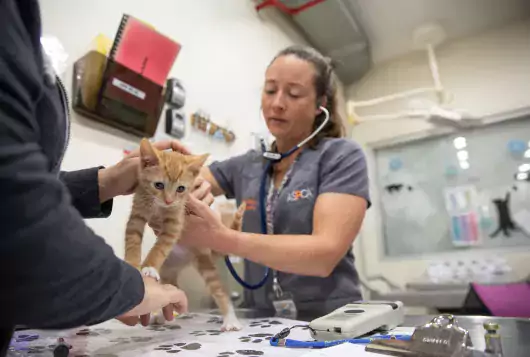How to Collect Animal Data

Counting animals-in and animals-out is essential to maintaining your organization's credibility — but that's just the beginning. What you really want to know is why animals are coming in and why not enough of those animals are making it out alive. That information will enable you to make sound program decisions and secure the community support and financial resources to implement them. That information will enable you to save more animals.
To achieve these goals from the data you collect, you need to have a system in place so that:
- You can extract meaningful information from the data.
- You can trust that the data is correct.
- You can look at your animal data from various perspectives and answer specific questions.
If your agency already uses shelter management software, you've got a key element in place. However, it's up to you to enter data consistently, completely, and in a timely fashion. If you want the data in your animal records to be reliable and useful, you've got to make time to do it right. Setting up a system for collecting and reporting your animal data, and training everyone involved, is essential to capturing usable data and being able to act on what it shows you.
The following steps will help you establish — or improve — a data collection system in your agency.
- Select one person to be in charge of data collection.
- Decide what items of data to collect.
- Decide how and where you will record and store this data.
- Engage shelter and field staff in the data collection process.
- Document your decisions, standards, and processes.
- Train the people who enter data and run reports.
- Look at your data regularly.
- Share your data, and talk about it.
- Use your data to communicate with the public.
1. Select one person to be in charge of data collection.
While it may not be possible to devote a staff position to managing data collection, one person should be given responsibility for keeping your statistics. Other staff may have data entry responsibilities, but we recommend designating one individual to oversee the process. In addition, you may want to designate this person as the primary contact for questions from staff about your shelter management software, and as the primary contact with the vendor of your software.
2. Decide what items of data to collect.
What do you want to be able to do with the data you collect? Run status reports for your board? Calculate intake statistics by town for animal control contracts? Use you spay/neuter data to generate support for a low-cost spay/neuter initiative?
Work backward from what you want to know to decide what data you'll need to collect. Identify the items of data you'll need to capture to get the results you are looking for.
- For some ideas to get you started, see What's the Deal about Data?
- For lists of the kinds of data to capture to answer your questions, see What Animal Data Do You Need?
3. Decide how and where you will record and store this data.
Shelter management software is specifically designed to help you collect and analyze your agency's animal data.
If you aren't using one of these programs, it's time to start:
- Every good shelter software program can track your animal statistics. Some of these programs are web-based and free, such as PetPoint, which can be used by agencies both very small and very large. Web-based programs typically require only a computer and an internet connection. No large investment in computer infrastructure is needed.
- Petfinder.com provides a Software Finder tool that compares the features of over two dozen programs and includes pricing and contact information. You can contact the vendors of programs that seem appropriate for your agency to learn more.
- We also recommend talking with other agencies that use these programs. Ask about pros and cons, costs, ease of implementation, and how well the software meets that agency's needs. After you choose a program, you may want to talk to agencies using the program for specific suggestions about setting up and using the program effectively.
If you have the software but aren't using its capabilities, it's time to revisit the subject:
- Contact the vendor of your software to learn more about using its features to meet your needs. Most vendors are happy to help customers use their software more effectively. For example, PetPoint provides setup, training and ongoing support at no cost their customers.
- Talk with other agencies using the same program. Ask about how they are using the program, and about policies and procedures in their agencies that have helped with effective data collection and reporting.
4. Engage shelter and field staff in the data collection process.
In order to gather detailed information about what happens to animals in your care, shelter and field staff — the people actually working with the animals on a daily basis — need to be involved in the process. They'll be much more inclined to keep good records if they understand how the data will be used and are trained to record information efficiently and consistently. In addition, shelter and field staff will have good insights about data collection in their areas of responsibility.
5. Document your decisions, standards, and processes.
If haven't already done so, create standard operating procedures (SOPs) for data collecting and reporting in your agency. These SOPs will help you:
- Train the people who will enter data and run reports (often they are different people)
- Provide a comprehensive resource identifying the data you collect and how your data collection system is set up and used
- Provide definitive answers to questions about "what goes in this field" or "why do we have to use this format"
For more about SOPs, see the articles on our SOP pages.
6. Train the people who enter data and run reports.
Take the time to train everyone who will be involved in data collection. You want to be sure that:
- Everyone knows what to do and where to turn if they have questions.
- Everyone is performing data collection and reporting tasks the same way.
7. Look at your data regularly.
Review your data regularly to see what you've got:
- Is the data entered accurately, completely, and consistently? If it's not, the data won't help you answer questions about your programs and the animals in your care. Work with your staff to identify the reasons for the problems you notice, and correct them as soon as possible.
- Are there trends in the data? Looking at numbers over time, such as month-to-month or quarterly, can reveal trends that may not be apparent when you are busily working in the thick of it day to day.
- Are there anomalies in the data? Is there an unexpected increase or decrease in numbers or other significant changes? Such changes can signal changes in areas of your operation that you will want to investigate.
8. Share your data, and talk about it.
Sadly, shelter reports too often end up gathering dust. Try posting your stats, weekly or monthly, where staff can view them. Or, better yet, review your data at weekly or monthly staff meetings, and use the information to spark discussions about ways to improve daily operations.
Your data should be a signpost to tell you what road to go down. It should drive your weekly or monthly action plans as well as any long-range strategic planning. One reason that PetPoint has become the most widely used program is its collaborative features. These enable agencies to interact by sharing data while transferring animals and to identify trends in their communities.
9. Use your data to communicate with the public about your agency and the animals and people you serve.
Always be honest when reporting your statistics to the public. And any time you report numbers, be sure to include what you've learned about the "why" behind the numbers, and say what you plan to do about it. Make sure the person who deals with the public and the media can present figures accurately and in context.
The more familiar you are with the data you have collected, the more effectively you will be able to address questions and even criticisms of your agency or its policies. Your data is also a very powerful tool for educating your community about who you help, how, and why.




